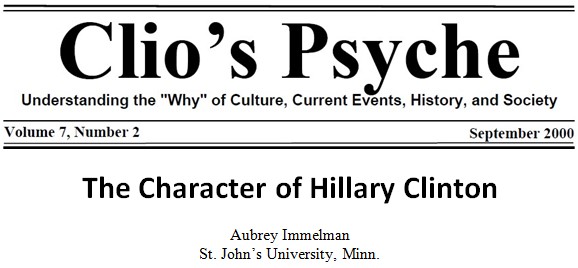The Character of Hillary Rodham Clinton
The Character
of Hillary Rodham Clinton

Cover of the May 30, 1994 issue of The New Yorker, featuring Connie Bruck’s article, “Hillary the pol.”
Aubrey Immelman
Unit for the Study of Personality in Politics
September 2000
“Can you be a misanthrope and still love and enjoy some individuals? “How about a compassionate misanthrope?” That enigmatic thought, expressed in the spring of 1967 by Wellesley sophomore Hillary Rodham in a letter to a friend, provides a valuable clue to the character of Hillary Rodham Clinton.
Last fall, my student Aví Bahadoor and I conducted a study of the political personality of Hillary Clinton. We collected personal data from published biographical materials and political reports, and synthesized those public records into a personality profile using the second edition of the Millon Inventory of Diagnostic Criteria (MIDC), which I adapted from the work of contemporary personality theorist Theodore Millon.
We found that Hillary Clinton’s primary MIDC scale elevations occurred as moderate loadings on the “Ambitious” and “Dominant” dimensions, with a more modest, subsidiary elevation on the “Conscientious” dimension. The Ambitious dimension is anchored at its adaptive pole by self-confidence and at its maladaptive pole by pathological narcissism. The Dominant dimension is anchored by, respectively, authoritativeness and pathological aggressiveness — the latter being conceptually related to “sadistic personality disorder,” listed in the appendix of the revised third edition of the American Psychiatric Association’s Diagnostic and Statistical Manual of Mental Disorders (1987) as a provisional personality disorder requiring further study. Finally, the Conscientious dimension ranges from conventional respectfulness to self-defeating compulsiveness.
The Millon Index of Personality Styles (1994), employing the label Asserting, describes Ambitious personalities as bold, competitive, and self-assured individuals who easily assume leadership roles, expect others to recognize their special qualities, and often act as though entitled. Dominant personalities — labeled Controlling — enjoy the power to direct others and to evoke obedience and respect. They are tough, competitive, and unsentimental, and often make effective leaders. This amalgam of adaptive narcissism and dominance in Hillary Clinton’s personality profile parallels the recollection of high school classmate Art Curtis, as quoted in Gail Sheehy’s (1999) Hillary’s Choice: “Hillary was very competitive at everything. Even pugnacious. She was very ambitious.”
In this report I will document some of the enduring personal characteristics that provide the empirical basis for my assessment of Hillary Clinton’s dominant, ambitious personality pattern.
After interviewing many of Clinton’s associates for a New Yorker article (“Hillary the pol,” May 30, 1994) Connie Bruck concluded, “In the end, the sureness about her own judgment — at its extreme, a sense that she alone is wise — is probably Hillary’s cardinal trait.” Evident in Bruck’s assessment is the dogmatic inflexibility characteristic of the cognitive style of highly conscientious, dominant personalities, tinged with the hubris of high ambition.
Commenting on the leadership implications of these traits, Stanley Renshon, in his 1996 book, High Hopes, had this to say: “The view that one knows better than others — period — can lead to imperiousness and cause trouble in one’s relations with others. It has done so in Hillary’s case.”
Renshon’s contention seems to be borne out by Elizabeth Drew. In her book, On the Edge (1994), she wrote that Hillary Clinton’s presence at health care meetings early in the Clinton presidency was a “source of discomfort,” with some attendees finding her “intimidating — hard to argue with and uninterested in the points they made. Mrs. Clinton’s style was very direct. She told people straight out what she thought. … Mrs. Clinton displayed a certain impatience. And her humor was biting.”
Drew’s reporting provides evidence of dominant behavior, but what evidence do we have that this is indicative of an enduring, consistent personality pattern rather than a situationally determined response simply reflecting Hillary Clinton’s seriousness of purpose concerning comprehensive health care?
Childhood nicknames sometimes provide a useful index of an individual’s ingrained, central personality traits. Among their mock predictions for seniors, Hillary Rodham’s high school newspaper proclaimed that Hillary’s destiny was to become a nun named “Sister Frigidaire.” “Obviously,” wrote celebrity biographer Norman King in The Woman in the White House (1996), “she was known for her ability to freeze anyone with a glare from her blue eyes.”
Just how tough is Hillary? James Carville, in All’s Fair: Love, War, and Running for President (1994), co-authored with Mary Matalin, put it this way: “Hillary won’t run you down for fun, and she won’t run into a ditch to avoid scratching your fender, but if you are blocking something we need to get done you’ll get run over in a hurry.” Less folksy, if more gravely, Bob Woodward reported in The Choice(1996) that Hillary occasionally “snapped at people, even blew up, providing a momentary glimpse of inner rage. She seemed angry, bottled up. Hillary was smart and determined, knew what she wanted to happen. When she was focused and directed, she often seemed not to recognize when she was hurting people.”
Lani Guinier, who once considered herself close to the Clintons, has written poignantly about this hurt. In “Who’s afraid of Lani Guinier?” (New York Times Magazine, Feb. 27, 1994), she related how, when her nomination for attorney general began to founder, she received neither emotional nor logistical support from her “friends in the White House.” She writes that Hillary Clinton first “breezed by” her in the West Wing “with a casual ‘Hi Kiddo’” and then, when someone tried to tell the first lady that she was there to strategize on her nomination, Hillary “turned slightly and said, ‘Oh,’” and “to no one in particular, announced, ‘I’m thirty minutes late for lunch.’” As Gail Sheehy has commented, “Empathy was not characteristic of Hillary.”
Millon proposes that the primary psychological precursor of an aggressive, controlling personality orientation is parental hostility. Sheehy describes Hillary’s father, Hugh Rodham, as an “authoritarian drillmaster” who “neither offered nor asked for nurturing.” “He was gruff and intolerant and also famously tightfisted: he shut off the heat in the house every night and turned a deaf ear to his children’s complaints that they woke up freezing in the morning. Toughen up was the message.” Sheehy writes that Hillary “tried hard … to please her father.” In It Takes a Village, Hillary Clinton wrote, “When I brought home straight A’s from junior high, my father’s only comment was, ‘Well Hillary, that must be an easy school you go to.’” Sheehy suggests that Hillary’s “drive toward perfection, her severe self-discipline and overwhelming need for control” are rooted in the tyranny of her father’s “demand for perfection and his readiness to demean his daughter.”
The foregoing touches primarily on Hillary Clinton’s dominant traits. What do we know about her ambitiousness? In this regard, Renshon writes that “one aspect of Hillary Rodham’s character” that stands out is her confidence in herself, her positions, and her work. Noting that both Bill and Hillary Clinton “are very ambitious and confident,” but that Hillary’s ambition “trumps her husband’s,” Renshon speculates that Hillary “appears to have developed … boundary problems” stemming from “her strong self-confidence in the correctness of whatever she does,” in contrast to her husband’s “failure to develop strong internal boundaries.” For both Clintons, the end result is a sense of entitlement — “a tendency to not want to be bound by limits that apply to others.”
It seems difficult to reconcile Hillary Clinton’s personality profile with her “It takes a village” persona. Part of the problem may be that character can be difficult to discern beneath a polished political persona. In one sense, Clinton has learned to soften publicly, as Bruck puts it, what others have viewed as the “hard edges” of her nature. But more importantly, clear perception of Hillary’s character can be easily confounded by her embrace of humanitarian political issues as a vehicle for political expression. Had she remained a Goldwater Republican and subscribed to the agenda of say, a Margaret Thatcher, the character traits that drive her political ambitions might well have been more transparent. The point is that character largely remains a constant, even as ideological values migrate under the press of political socialization.
Acknowledgments
A slightly edited version of this paper was published in Clio’s Psyche (Journal of the Psychohistory Forum), vol. 7, no. 2 (September 2000), pp. 65–66.
Aví Bahadoor, a biology/pre-med major at the College of St. Benedict, assisted with the data collection for this paper.
Related report

Immelman, A. (2000, September). The character of Hillary Clinton. Clio’s Psyche, 7(2), 65–66. Retrieved from Digital Commons website: https://digitalcommons.csbsju.edu/psychology_pubs/13/
Abstract: This essay documents some of the enduring personal characteristics that provide an empirical basis for assessing Hillary Rodham Clinton’s dominant, ambitious personality pattern from a psychobiographical, psychohistorical perspective.










Follow Aubrey Immelman